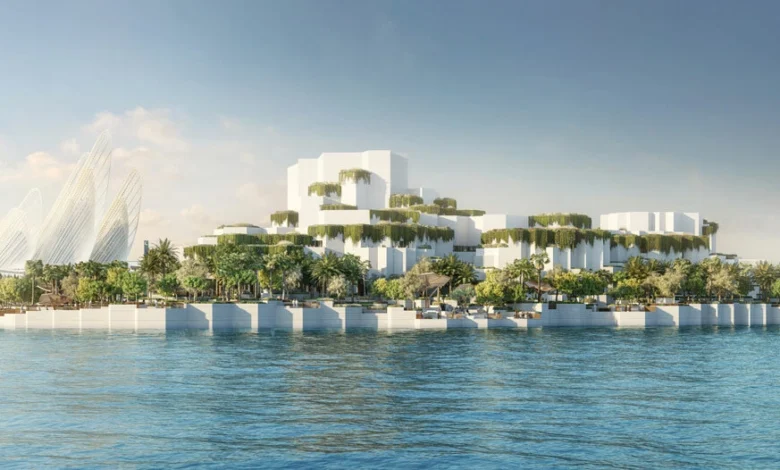
The Natural History Museum Abu Dhabi Unveils Rare Dinosaurs, Giant Blue Whale
The Natural History Museum Abu Dhabi will open its doors on November 22, 2025, becoming a global hub for science, nature, and culture. This landmark stands as the region’s largest museum, spanning an impressive 35,000 square meters. Visitors can begin a journey through 13.8 billion years of natural history within its walls.
The museum’s collection features three remarkable “travelers from deep time” that will without doubt engage every guest. Stan, the museum’s crown jewel, is a nearly complete Tyrannosaurus rex skeleton from about 67 million years ago. On top of that, the museum houses a spectacular 25-meter female blue whale specimen – the largest known animal to ever exist. The collection also includes the fascinating Murchison Meteorite, which contains 7-billion-year-old grains that predate our Solar System. These incredible specimens make the Natural History Museum Abu Dhabi a must-visit destination in the Saadiyat Cultural District for anyone fascinated by Earth’s remarkable story.
Museum traces 13.8 billion years of Earth’s story
Image Source: American Museum of Natural History
The Natural History Museum Abu Dhabi tells Earth’s remarkable story through its exhibition spaces. Visitors walk through galleries that showcase our planet’s development from the Big Bang’s cosmic origins to today’s ecosystems and what lies ahead.
The museum’s extensive galleries present Earth’s story through carefully selected exhibits. The journey begins with the universe’s formation. Visitors then move through areas that show how early microorganisms emerged. They can see displays that tell the story of dinosaurs’ rise and extinction. The next sections reveal how mammals developed, humans originated, and today’s biodiversity came to be.
The museum brings ancient worlds back to life with cutting-edge technology. Visitors can step into prehistoric landscapes through interactive displays, immersive environments, and digital recreations. The museum’s innovative presentation methods place its star specimens in their natural settings. Stan the T-rex stands in its Cretaceous environment, while the blue whale floats in oceanic surroundings.
The galleries flow together to create a timeline that shows how geological processes, climate changes, and evolutionary adaptations have shaped Earth’s life. This scientific institution on Saadiyat Island works like a time machine. Visitors witness Earth change over billions of years – from early oceans to ice ages to modern environments – all in one visit.
Scientific research and education drive museum’s mission
Image Source: American Museum of Natural History
The Natural History Museum Abu Dhabi shows impressive displays that reflect its steadfast dedication to advancing scientific knowledge and promoting education. This facility focuses on scientific research, unlike other cultural institutions in the Saadiyat Cultural District such as the Zayed Museum Abu Dhabi.
Scientists will use the museum’s research laboratories to study natural specimens and add to our global understanding of biodiversity, development, and conservation. Their research directly shapes the exhibits, giving visitors the most accurate and current scientific information. The museum has built mutually beneficial alliances with leading international research institutions to build its scientific foundation.
Educational programs are a key part of the museum’s mission. Visitors of all ages can try hands-on experiments in interactive learning spaces throughout the facility to understand scientific concepts better. School programs that line up with educational curricula help young visitors develop critical thinking skills while they learn about natural history.
The museum will host specialized workshops, lecture series, and community science projects where the public can participate in actual research. Digital learning tools will help spread the museum’s educational impact beyond in-person visits.
The Natural History Museum Abu Dhabi wants to inspire future scientists from the UAE and around the world. Through its showcase of ancient natural wonders and modern scientific methods, the museum demonstrates that scientific discovery is an ongoing, developing process—one that today’s visitors might join tomorrow.
Architectural design and cultural context shape visitor journey
Image Source: Designboom
The Natural History Museum Abu Dhabi, designed by the famous Dutch architecture firm Mecanoo, rises from Saadiyat Island like natural rock formations. This design approach aligns with the museum’s main goal to help visitors better understand the natural world.
Geometric patterns define the building’s unique design. Pentagonal shapes that mirror cellular structures appear throughout the structure. The architects integrated water and vegetation, which symbolize desert life, into the building’s story. These design elements create an environment where the building teaches visitors about nature.
The museum will be a remarkable landmark in the Saadiyat Cultural District and spans over 35,000 square meters. It will stand alongside other cultural giants like Louver Abu Dhabi, the upcoming Zayed National Museum, and Guggenheim Abu Dhabi.
This museum stands out because it tells the story of natural history through Arabian eyes. H.E. Mohamed Khalifa Al Mubarak, Chairman of the Department of Culture and Tourism – Abu Dhabi, explains: “The museum offers an immersive look at the story of life on Earth, framed for the first time through an Arabian lens, with the fauna, flora, and geological history of the region forming a prominent part of the visitor journey.”
The Natural History Museum Abu Dhabi will reshape the scene of science and culture in the region when it opens in November 2025. Visitors can begin a unique experience through exhibition spaces that cover 35,000 square meters and span 13.8 billion years. Of course, the museum’s main attractions will amaze everyone – Stan the T-rex, a magnificent blue whale specimen, and the ancient Murchison Meteorite serve as windows into our planet’s past.
This museum does more than display specimens. Research laboratories and educational programs actively advance scientific knowledge. Students and visitors can learn through school programs, workshops, and interactive spaces that make natural history available to everyone.
Mecanoo designed the building to mirror natural rock formations with pentagonal shapes that draw inspiration from cellular structures. The structure features water and vegetation elements throughout to showcase how life thrives in desert environments. This design helps visitors connect with nature as the building becomes part of their learning experience.
The museum’s most important feature is its unique Arabian view of natural history. Regional plants, animals, and geological features tell Earth’s story in a new way. This fills a vital gap in scientific and cultural conversations while adding to other prestigious venues in the Saadiyat Cultural District.
The Natural History Museum Abu Dhabi goes beyond being just a collection of ancient specimens. It shows Abu Dhabi’s steadfast dedication to science, education, and culture. People who walk through its halls will see not only Earth’s history but also what a world of scientific discovery and regional heritage might bring.




